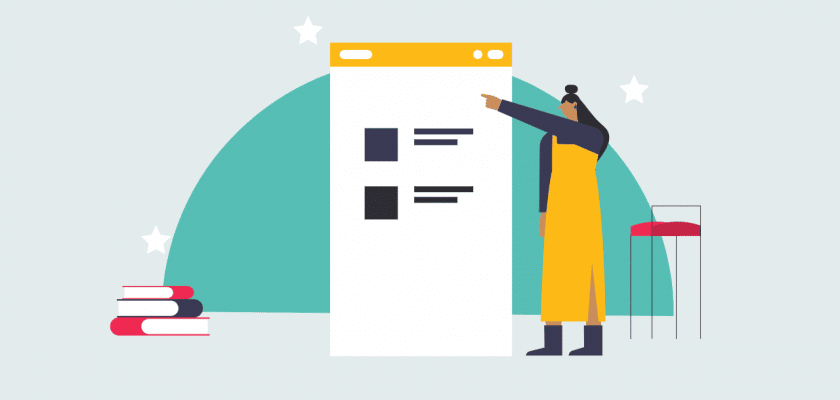It’s safe to say that every teacher’s nightmare revolves around finishing a lesson 15 minutes too soon. The mere seconds you have to come up with an activity to keep your students engaged until the bell rings may seem like a lifetime. My dear teacher, if this happens to you often, you should stop guessin’ plannin’ your lessons.
You shouldn’t make a habit of going into a classroom and making up a plan as you go. Sooner or later, it’s going to come back to bite you. Instead, you need a good lesson plan to keep you organized and on schedule. Writing a lesson plan can be tedious, but it’s paramount for teaching successfully.

Source: @zdoragel via Twenty20
What Is a Lesson Plan?
A lesson plan is a teacher’s guide through the class. It serves to help you stay on track and make sure you use class time efficiently (and to never have too much of it again!). A high-quality lesson plan includes a clear timeline you can stick to but will also offer some leeway to make sure that all students can keep up with the lesson and the information you present.
While lesson plans are for teachers, they have to be focused on students. Your lesson plan should aim at helping students learn a skill, form an opinion, or gain knowledge.
Lesson plans don’t have to be long, but they need to be detailed enough to cover all your class’s essential elements.
If you’re new to writing lesson plans, you can use a lesson plan template to structure your writing process and help you speed up the lesson planning process. Make sure you use a template that fits your needs. You can find different templates for daily, weekly, and yearly plans.
Types of Teacher Lesson Plans
Lesson plans come in all shapes and sizes, depending on the subject, grade, and planning scope.
For example, teaching kindergarten and middle school students brings different challenges. Lesson plans for kindergarten contain more games and fun activities to keep the kids engaged, while middle school lesson plans turn more and more to increasingly complex concepts and assessments of students’ performance.
Check out the table to see the common lesson plan categories:
| Lesson Plan Categories | Examples of Lesson Plans |
| Grade | Preschool Kindergarten 1st grade 2nd grade High school |
| Duration | Daily Weekly Monthly Individual |
| Subject | Math Language arts ESL classes Science Social studies |
Basic Lesson Plan Elements
A high-quality lesson plan covers all the crucial aspects of teaching a successful class. It gives you a clear goal that you can focus on and helps you prepare for various scenarios, such as having some spare time at the end of the lesson, not having enough time to finish the lesson, or not having enough students present to begin with.
The most important lesson plan elements that ensure your classes run the intended course are as follows:
- Objectives
- Materials
- Pre-assessment
- Instruction and practice
- Assessment
Objectives
A lesson plan objective is the first and the most important element you need to define when writing a lesson plan. It determines everything else that you’re going to write afterward. Every lesson you teach needs to have an answer to the question, “Why am I teaching this?” or “What is the outcome?”
Your lesson objective is supposed to be a clear, concise goal for your class to keep you focused on what you need to achieve with your teaching. To set a good objective, you should stick to the S.M.A.R.T. format since your objective has to be:
- Specific
- Measurable
- Attainable
- Relevant
- Timely
At the end of any lesson, you’ll need to assess whether you’ve achieved your goal or not. An objective must not be vague or unquantifiable. Use verbs that promote concrete action, such as identify, define, tell, contrast, support, and summarize. Verbs like understand and be familiar with are of no use as they represent concepts that are hard to measure and assess.
Take a look at these two examples:
- Students will be able to tell the time on an analog clock with 80% accuracy—This objective has every necessary detail. Students will be asked to do a specific action (tell the time) in defined circumstances (on an analog clock). It also provides the requirements they need to meet to accomplish the objective (80% accuracy)
- Students will learn about telling the time—An objective like this is too vague. What does learning about something actually mean? It can refer to waxing poetic about the history of telling time and calendars as much as teaching kids what 3 p.m. looks like on a clock
Materials
This section should contain a list of all the necessary materials you’re going to use throughout the class to achieve your objective. The type of materials you will use depends on the subject, grade, and planned activities.
Lesson materials can include:
- Textbooks
- E-books
- Audiobooks
- Project instructions
- PowerPoint presentations
- Projectors
- Scissors
- Glue
- Paint
- Worksheets
- PC
- Flash cards
- Games
- Crayons
- Paper
- Printables
- Notebooks
- Stickers

Source: @vesnoi_ via Twenty20
Pre-Assessment
A lesson plan should focus on students. You need to take into account who your students are, specifically their:
- Background knowledge
- Learning styles and abilities
- Interests
Thinking about these items will help you adapt your approach to get the most out of your class. In this stage of lesson planning, you need to assess whether the lesson will be easy or hard for your students to master so you can allocate time accordingly.
To gauge the students’ knowledge and interests, ask your students questions to see how much they’re familiar with the subject of your lesson.
For example, if you’re going to talk about African fauna, ask them whether they can tell the difference between deserts and savannas, what animals from Africa they know, and what African rivers they’ve heard of.
Instruction and Practice
The instructional section helps you define how the lesson will pan out. You can divide this part of your plan into different sections or steps and write down their order, the time each part will take, and ways to transition to the next step.
Try to think about the ways you’ll introduce the topic, how you’ll incite critical thinking, what real-life events you can connect the lesson to, and whether you can introduce group work. List the activities that you will use for practice, and be as specific as necessary.
The way you organize direct instruction depends on your teaching style and your group of students. Here’s an example of what your structure could look like:
- Warm-up
- Introduction to the topic
- Presentation
- Activity or activities for practicing
- Practice evaluation
- Application and reinforcement of new knowledge or skill
Assessment
It’s time to be the judge.
This is the segment where you define how you’re going to assess the students’ understanding of the lesson and see whether you’ve achieved your objective. In other words, you need to define how you’re going to test if your students have learned the new concept to an acceptable level.
Common assessment methods include:
- Exit slips
- Quizzes
- Writing assignments
- Hands-on activities
- Class journal entries
- Presentations
- Group activities
- Drills

Source: @lithiumphoto via Twenty20
Using Online Lesson Plans
Lesson planning from scratch is not a walk in the park. You can bypass the entire process of writing a lesson plan on your own by finding a ready-made plan online. Somebody already went through the pain of making a lesson plan for that particular class and made the material available online—no reason you shouldn’t use it.
You can find countless lesson plans online, but the problem is that the quality of free resources is often sub-par, and you need to shell out money to get those that are usable. You can spot a bad free plan from miles away if it has a vague lesson plan objective, doesn’t go over the necessary materials, or doesn’t meet your curriculum standards.
Finding high-quality lesson plans is tricky even if you pay to download them. They’re hiding behind a paywall, and you can get only previews for free, but those snippets don’t give you enough information to determine whether a particular plan will work for you. You’ll need to spend money on it before you can see if it’s a plan you can use or not.
Most teacher resource websites charge per download, and you can spend hundreds of dollars on unusable lesson plans before you find the right one—not to mention the time wasted on searching for a lesson plan that would work.
Find the Best Lesson Plan With Teach Simple
You can spend hours browsing various websites looking for a lesson plan that will meet the needs of your class and the formal requirements of the curriculum. The worst part is that you will spend big money each year on lesson plans and additional teaching materials.
You can skip the long research process and avoid paying over the odds for unusable materials by using Teach Simple. Every teaching material we offer is created by a teacher with years of experience. The best part is that our platform is subscription-based, meaning you can make unlimited downloads without additional costs and save hundreds of dollars along the way.
What Can You Find on Teach Simple?
Besides unlimited downloads, you’ll benefit from the diversity of resources that can help you step up your teaching game and make your classes more enjoyable, fun, and efficient. Aside from lesson plans, you can use Teach Simple to download curriculums, flash cards, games, e-books, audiobooks, worksheets, various graphics, and so much more.
Our materials cover all grades from pre-K to high school.
Every resource that we post is made and reviewed by experienced teachers to ensure it is of high quality and that it meets formal standards. Here’s just a preview of what you can expect on our website:
- African Elephants | Interactive Science Lesson
- Mars | Interactive Science Lesson
- Caves and Cave Formation—Lesson Bundle
- Cell Introduction
- Science Fast Facts: Animals, Human Body, Insects and Arachnids, Oceanography, Solar System, Weather
- Genetic Disorders—5E Lesson Bundle
- Discover! Plants
- Atoms and the Periodic Table (Middle School Chemistry)—Lesson Bundle
- The World’s Deepest Volcanic Vents | Interactive Science Lesson
- Scream Machines (Roller Coasters): Emergency Lesson Plan
- A Paired Text Reading and Writing Unit: Wind Energy
- Gas | Interactive Science Lesson
- Atoms and Static Electricity
- The Elementary Geographer: Latitude & Longitude
- Sports Kids Love, Gr. 1
Teach Simple helps educators teach beyond standard academic expectations. On our website, you can find resources for special ed students, speech therapy resources, and materials for social-emotional learning.
Our platform supports the teachers who create the materials we offer. That’s why 50% of the revenue goes back to our contributors.
Get Free High-Quality Lesson Plans
You can sign up for Teach Simple for free with our 30-day trial. During this period, you can download as many lesson plans as you want without any commitments toward continuing your subscription once the trial runs out.
Once you experience our easy-to-use platform that offers thousands of top-notch materials for your classes, we’re sure you’ll stay with Teach Simple. We can help you forget about planning the lessons from scratch or spending your hard-earned dollars on disappointing resources all over the web.
